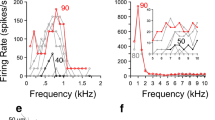Abstract
Pharmacological agents (strychnine, picrotoxin, pentobarbital, chloralose, GABA, penicillin, morphine) were used to investigate the nature of the slow potential recorded in the frog olfactory bulb in response to natural stimulation. Three possible hypotheses were tested: 1) The slow potential is neuroglial in nature; 2) it is the analog of the dorsal-root potential of the spinal cord and reflects depolarization of primary afferents arising in the terminals of the olfactory nerve and responsible for presynaptic inhibition in the frog olfactory bulb; 3) the slow potential reflects postsynaptic processes. The results showed great similarity between changes in the slow and dorsal-root potentials of the spinal cord in response to the action of pharmacological agents. However, the slow potential is evidently a complex response and incorporates at least one other component — depolarization of the dendrites of unknown nature.
Similar content being viewed by others
Literature cited
G. S. Voronkov and K. G. Gusel'nikova, “Inhibition in the olfactory bulb at the glomerular level,” Zh. Vyssh. Nerv. Deyat.,17, 744 (1967).
G. S. Voronkov and K. G. Gusel'nikova, “Presynaptic inhibition in the frog olfactory bulb,” Zh. Vyssh. Nerv. Deyat.,18, 909 (1968).
K. G. Gusel'nikova, G. S. Voronkov, L. E. Tsitolovskii, and V. V. Éngovatov, “The nature of the main components of the orthodromie potential and inhibition of secondary neurons of the frog olfactory bulb,” Zh. Vyssh. Nerv. Deyat.,20, 649 (1970).
A. I. Roitbak, “Recent data and views relating to functions of the neuroglia,” in: Integrative Activity of the Nervous System under Normal and Pathological Conditions [in Russian], Meditsina, Moscow (1968), pp. 79–96.
L. V. Kharitonovich, “Comparative morphology of the olfactory bulbs of carnivorous mammals,”Author's Abstractor Candidate's Dissertation, Minsk (1972).
J. L. Barker and R. A. Nicoll, “Gamma-aminobutyric acid: role in primary afferent depolarization,” Science,176, 1043 (1972).
I. A. Bell and E. G. Anderson, “The influence of semicarbazide induced depletion of gamma-amino-butyric acid on presynaptic inhibition,” Brain Res.,43, 161 (1972).
R. A. Davidoff, “Penicillin and presynaptic inhibition in the amphibian spinal cord,” Brain Res.,36, 218 (1972).
N. Davidson and C. A. P. Southwick, “Ammo-acids and presynaptic inhibition in the rat cuneate nucleus,” J. Physiol. (London),219, 689 (1971).
J. C. Eccles, R. Schmidt, and W. D. Willis, “Pharmacological studies on presynaptic inhibition,” J. Physiol. (London),168, 500 (1963).
A. van Herreveld and A. Niechaj, “A possibly monosynaptic component of the dorsal root potential,” Brain Res.,19, 105 (1970).
D. Ottoson, “Studies on slow potentials in the rabbit's olfactory bulb and nasal mucosa,” Acta. Physiol. Scand.,47, 136 (1959).
D. Ottoson, “Comparison of slow potentials evoked in the frog's nasal and olfactory bulb by natural stimulation,” Acta Physiol. Scand.,47, 149 (1959).
P. Rudomin and J. Munor-Martinez, “A tetrodotoxin resistant primary afferent depolarization,” Exper. Neurol,25, 106 (1969).
R. F. Schmidt, “Pharmacological studies on the primary afferent depolarization of the toad spinal cord,” Pflug. Arch. Ges. Physiol.,277, 325 (1963).
A. K. Tebecis and J. W. Phillis, “The use of convulsants in studying possible functions of amino acids in the toad spinal cord,” Comp. Biochem. Physiol.,28, 1303 (1969).
S. Ueky and T. Fukuda, “Effects of central nervous stimulants on the electrical activity of the olfactory bulb in rabbits,” Fukuoka Acta. Med.,57, 909 (1966).
P. D. Wall, “Excitability changes in afferent fiber terminations and their relation to slow potentials,” J. Physiol.,14, 1 (1953).
C. Yamamoto, “Oscillation potential in strychninized olfactory bulb,” Jap. J. Physiol.,12, 14 (1962).
Author information
Authors and Affiliations
Additional information
Translated from Neirofiziologiya, Vol. 7, No. 4, pp. 372–379, July–August, 1975.
Rights and permissions
About this article
Cite this article
Gusel'nikova, K.G., Ivanova, L.V. & Kipor, G.V. Pharmacological analysis of slow potentials recorded in frog olfactory bulb during natural stimulation. Neurosci Behav Physiol 7, 89–94 (1976). https://doi.org/10.1007/BF01148756
Received:
Issue Date:
DOI: https://doi.org/10.1007/BF01148756




